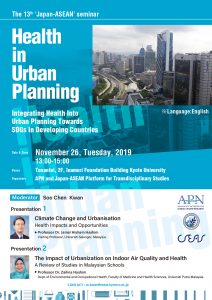 日時: November 26, 2019 13.00 – 15.00 p.m.
日時: November 26, 2019 13.00 – 15.00 p.m.
場所: Tonantei Room, 2F Inamori Foundation Building
Moderator: Soo Chen Kwan
Presentation 1: Climate Change and Urbanisation: Health Impacts and Opportunities
Professor Dr. Jamal Hisham Hashim
Visiting Professor, Universiti Selangor, Malaysia.
Abstract:
Climate change is now an inevitable global phenomenon and consequence. In September 2016, the world crossed the threshold of 400 ppm carbon dioxide concentration in the atmosphere. With the global temperature rise now stands at 1 oC, it means that we will not be able to cap global temperature rise to 1.5 oC, but will have to work hard to avoid a 2 oC increase. This might already spells disaster for the low-lying small island states, with serious repercussions around the world from more extreme heat waves to droughts, coastal flooding and the extinction of many coral reefs. More of the world’s population now live in urban than in rural areas. Modern megacities may have been an invention of the West, but they are now increasingly found in the East, as 7 of the 10 largest megacities are now found in Asia. Many urban centres in Asia like Jakarta and Bangkok are vulnerable to the impacts of climate change as they are located in coastal flood plains. The big floods of 2011 in Thailand and 2014 in East Malaysia are most likely the consequences of climate change. The other weather extreme from climate change would translate into drought which is normally accompanied with forest fires and haze. Persistent haze triggered by El Nino, believed to be precipitated by climate change, has been a regular occurrence in Southeast Asia since 1997, affecting large urban centres like Singapore, Kuala Lumpur and Kuching. In 2015, it is estimated that 100,300 excess deaths due to the haze occurred in Indonesia, Malaysia and Singapore. Climate change, urbanisation and air pollution will present us with the greatest environmental and health challenges globally, but especially so in the highly populated urban Asia. Our responses to these challenges lie not just in our ability to mitigate but also on how to adapt to our new world.
Presentation 2: The Impact of Urbanization on Indoor Air Quality and Health: A Review of Studies in Malaysian Schools
Professor Dr. Zailina Hashim
Dept. of Environmental and Occupational Health, Faculty of Medicine and Health Sciences, Universiti Putra Malaysia
Abstract:
Malaysia is currently one of the most urbanized countries of East Asia, and one of the most rapidly urbanized regions around the world. Over the last ten years, the urban population in Malaysia has increased from around 66 percent in 2004 to 74 percent in 2014. This growth is expected to continue, as people from rural areas migrate to urban areas due to the economy and employment continuing to shift from agriculture to industry and services. As a result, with the increase of population and human activities in the cities, the air quality has deteriorated. Many studies have confirmed that indoor air quality is highly affected by outdoor air quality. Indoor pollution can be even more deadly because it affects you in places where you spend 80% or more of your time each day. From previous combined indoor and outdoor air quality studies in literature, more than 2/3 have found indoor air pollutant concentration higher than outdoor. This is also due to additional indoor sources of volatile chemicals such as formaldehyde, organic carbon compound, mold and fungus from building materials, furniture, wall paint and ceilings.
This presentation will discuss on the findings of studies conducted on secondary schools and students in the urban areas of Kajang and Bangi, Kota Kinabalu, Penang, Kuala Lumpur, Kuantan and Johor Baru. In Malaysian schools, the indoor air quality is almost the same as the ambient outdoor air because the classes were open air and equipped with fans for ventilation without having any air conditioning system. In these studies, the indoor air parameters were measured, and the health of the students were assessed using biomarkers such as blood, sputum and cheek cells or by measuring respiratory conditions such as the lung function and lung inflammation, the genotoxicity and reported respiratory symptoms from questionnaires. Overall, the indoor air quality in urban schools were worse than the suburban schools with the highest pollutant were respirable PM10 and PM2.5, mainly from motor vehicle exhausts. In Kota Kinabalu schools, the particulate levels were significantly related with lung function impairment and lung inflammation, while the volatile organics were mainly related with respiratory infection, cough and phlegm formation. The findings in Kajang and Bangi also showed that the lung inflammation (FeNO level) among asthmatic were mainly contributed by the PM2.5. In Penang, there were associations between reported respiratory symptoms among students, with the fungal DNA in dusts and the PM2.5 indoor. In the early 90’s, when leaded gasoline from motor vehicles were the major source of atmospheric lead, students in the Kuala Lumpur city were highly exposed to atmospheric lead. The indoor lead conc. in the city center was twice higher (0.170 ㎍/m3) than the rural areas (0.078 ㎍/m3). In bauxite mining areas near Kuantan city, high levels of PM10 were associated with various reported respiratory symptoms as well as skin itchiness. Nasal congestion (45.5%) was the highest respiratory symptoms experienced. Other risk factors were the proximity of their houses to the mining areas, young age and low family income. Recently, school children in Pasir Gudang industrial areas near Johor Baru city, were poisoned by inhaling organic compound from illegal dumping. Due to the hot weather, chemical dumped into a river, vaporised and blown by wind to the schools nearby. Exposed students were medical treated on site and many were brought to the hospitals.
Urbanization is good for the economic development and employment but the most pressing problems facing the cities today are poverty and environmental degradation. With the rapid urbanization as well as with the advent of climate change, there is a concern if our environmental development is sustainable.